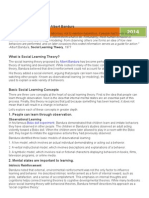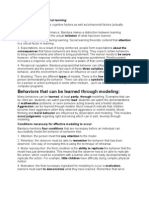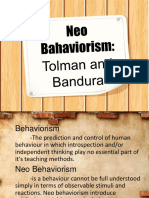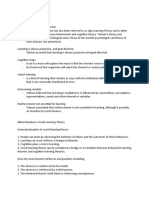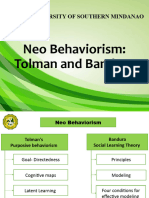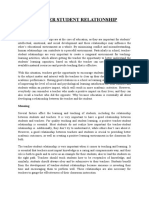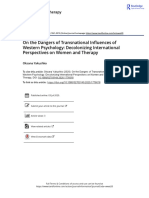MBA NOTES 1st Semester
MBA NOTES 1st Semester
Uploaded by
MaxagacyCopyright:
Available Formats
MBA NOTES 1st Semester
MBA NOTES 1st Semester
Uploaded by
MaxagacyCopyright
Available Formats
Share this document
Did you find this document useful?
Is this content inappropriate?
Copyright:
Available Formats
MBA NOTES 1st Semester
MBA NOTES 1st Semester
Uploaded by
MaxagacyCopyright:
Available Formats
Social learning theory focuses on the learning that occurs within a social context.
It considers that people learn from one another, including such concepts as observational learning, imitation, and modeling. Among others Albert Bandura is considered the leading proponent of this theory.
General principles of social learning theory follows:
1. People can learn by observing the behavior is of others and the outcomes of those behaviors. 2. Learning can occur without a change in behavior. Behaviorists say that learning has to be represented by a permanent change in behavior, in contrast social learning theorists say that because people can learn through observation alone, their learning may not necessarily be shown in their performance. Learning may or may not result in a behavior change. 3. Cognition plays a role in learning. Over the last 30 years social learning theory has become increasingly cognitive in its interpretation of human learning. Awareness and expectations of future reinforcements or punishments can have a major effect on the behaviors that people exhibit. 4. Social learning theory can be considered a bridge or a transition between behaviorist learning theories and cognitive learning theories. How the environment reinforces and punishes modeling: People are often reinforced for modeling the behavior of others. Bandura suggested that the environment also reinforces modeling. This is in several possible ways: 1, The observer is reinforced by the model. For example a student who changes dress to fit in with a certain group of students has a strong likelihood of being accepted and thus reinforced by that group. 2. The observer is reinforced by a third person. The observer might be modeling the actions of someone else, for example, an outstanding class leader or student. The teacher notices this and compliments and praises the observer for modeling such behavior thus reinforcing that behavior. 3. The imitated behavior itself leads to reinforcing consequences. Many behaviors that we learn from others produce satisfying or reinforcing results. For example, a student in my multimedia class could observe how the extra work a classmate does is fun. This student in turn would do the same extra work and also receive enjoyment. 4. Consequences of the models behavior affect the observers behavior vicariously. This is known as vicarious reinforcement. This is where in the model is reinforced for a response and then the observer shows an increase in that same response. Bandura illustrated this by having students watch a film of a model hitting a inflated
clown doll. One group of children saw the model being praised for such action. Without being reinforced, the group of children began to also hit the doll . Contemporary social learning perspective of reinforcement and punishment: 1. Contemporary theory proposes that both reinforcement and punishment have indirect effects on learning. They are not the sole or main cause. 2. Reinforcement and punishment influence the extent to which an individual exhibits a behavior that has been learned. 3. The expectation of reinforcement influences cognitive processes that promote learning. Therefore attention pays a critical role in learning. And attention is influenced by the expectation of reinforcement. An example would be, where the teacher tells a group of students that what they will study next is not on the test. Students will not pay attention, because they do not expect to know the information for a test. Cognitive factors in social learning: Social learning theory has cognitive factors as well as behaviorist factors (actually operant factors). 1. Learning without performance: Bandura makes a distinction between learning through observation and the actual imitation of what has been learned. 2. Cognitive processing during learning: Social learning theorists contend that attention is a critical factor in learning. 3. Expectations: As a result of being reinforced, people form expectations about the consequences that future behaviors are likely to bring. They expect certain behaviors to bring reinforcements and others to bring punishment. The learner needs to be aware however, of the response reinforcements and response punishment. Reinforcement increases a response only when the learner is aware of that connection. 4. Reciprocal causation: Bandura proposed that behavior can influence both the environment and the person. In fact each of these three variables, the person, the behavior, and the environment can have an influence on each other. 5. Modeling: There are different types of models. There is the live model, and actual person demonstrating the behavior. There can also be a symbolic model, which can be a person or action portrayed in some other medium, , such as television, videotape, computer programs.
Behaviors that can be learned through modeling:
Many behaviors can be learned, at least partly, through modeling. Examples that can be cited are, students can watch parents read, students can watch the
demonstrations of mathematics problems, or seen someone acting bravely and a fearful situation. Aggression can be learned through models. Much research indicate that children become more aggressive when they observed aggressive or violent models. Moral thinking and moral behavior are influenced by observation and modeling. This includes moral judgments regarding right and wrong which can in part, develop through modeling. Conditions necessary for effective modeling to occur: Bandura mentions four conditions that are necessary before an individual can successfully model the behavior of someone else: 1. Attention: the person must first pay attention to the model. 2. Retention: the observer must be able to remember the behavior that has been observed. One way of increasing this is using the technique of rehearsal. 3. Motor reproduction: the third condition is the ability to replicate the behavior that the model has just demonstrated. This means that the observer has to be able to replicate the action, which could be a problem with a learner who is not ready developmentally to replicate the action. For example, little children have difficulty doing complex physical motion. 4. Motivation: the final necessary ingredient for modeling to occur is motivation, learners must want to demonstrate what they have learned. Remember that since these four conditions vary among individuals, different people will reproduce the same behavior differently. Effects of modeling on behavior: Modeling teaches new behaviors. Modeling influences the frequency of previously learned behaviors. Modeling may encourage previously forbidden behaviors. Modeling increases the frequency of similar behaviors. For example a student might see a friend excel in basketball and he tries to excel in football because he is not tall enough for basketball. Self efficacy: People are more likely to engage in certain behaviors when they believe they are capable of executing those behaviors successfully. This means that they will have high self-efficacy. In layman's terms self-efficacy could be looked as self confidence towards learning.
How self-efficacy affects behavior:
Joy of activities: individuals typically choose activities they feel they will be successful in doing. Effort and persistence: individuals will tend to put more effort end activities and behaviors they consider to be successful in achieving. Learning and achievement: students with high self-efficacy tend to be better students and achieve more. Factors in the development of self efficacy: In general students typically have a good sense of what they can and cannot do, therefore they have fairly accurate opinions about their own self-efficacy. In my multimedia program, the challenge is to increase student self-efficacy. There are many factors which affect self efficacy. Some of these factors can be; previous successes and failures, messages received from others, and successes and failures of others. Note example of ACS and Cliff & Vanessa. Self regulation: Self-regulation has come to be more emphasized in social learning theory. Selfregulation is when the individual has his own ideas about what is appropriate or inappropriate behavior and chooses actions accordingly. There are several aspects of self regulation: Setting standards and goals Self observation Self judge Self reaction Promoting self-regulation can be an important technique. This is usually done by teaching the individual to reward himself after doing the needed behavior. For example, a graduate student will tell himself to complete a certain chapter before taking a break and relaxing. Self instructions: An effective strategy is to teach learners to give themselves instructions that guide their behavior. There are five steps to achieve this goal: Cognitive modeling: Overt external guidance Overt self guidance Faded, overt self guidance
covert self instruction
Self monitoring and self reinforcement: These are two ways that people can control their own behavior. First they monitor and observe their own behavior, sometimes even scoring behavior. Secondly, people are also able to change their behavior by reinforcing themselves, by giving are withholding reinforcement.
Educational implications of social learning theory:
Social learning theory has numerous implications for classroom use. 1. Students often learn a great deal simply by observing other people. 2. Describing the consequences of behavior is can effectively increase the appropriate behaviors and decrease inappropriate ones. This can involve discussing with learners about the rewards and consequences of various behaviors. 3. Modeling provides an alternative to shaping for teaching new behaviors. Instead of using shaping, which is operant conditioning, modeling can provide a faster, more efficient means for teaching new behavior. To promote effective modeling a teacher must make sure that the four essential conditions exist; attention, retention , motor reproduction, and motivation. 4. Teachers and parents must model appropriate behaviors and take care that they do not model inappropriate behaviors. 5. Teachers should expose students to a variety of other models. This technique is especially important to break down traditional stereotypes. 6. Students must believe that they are capable of accomplishing school tasks. Thus it is very important to develop a sense of self-efficacy for students. Teachers can promote such self-efficacy by having students receive confidence-building messages, watch others be successful, and experience success on their own. . 7. Teachers should help students set realistic expectations for their academic accomplishments. In general in my class that means making sure that expectations are not set too low. I want to realistically challenge my students. However, sometimes the task is beyond a student's ability, example would be the cancer group. 8. Self-regulation techniques provide an effective method for improving student behavior.
You might also like
- Social Learning Theory Paper-FinalDocument6 pagesSocial Learning Theory Paper-Finalapi-346593898No ratings yet
- Social Learning Theory by Albert BanduraDocument2 pagesSocial Learning Theory by Albert BanduraDENNIS AFABLE100% (2)
- 210jmetke-Low Floor High Ceiling HandoutsDocument5 pages210jmetke-Low Floor High Ceiling Handoutsapi-444818664No ratings yet
- ACT & Mindfulness at Work - Steven C. Hayes, Frank W. Bond, Dermot Barnes-HolDocument186 pagesACT & Mindfulness at Work - Steven C. Hayes, Frank W. Bond, Dermot Barnes-HolDavid Espinola100% (4)
- Bandura - Social LearningDocument7 pagesBandura - Social LearningPeteNo ratings yet
- Social Learning TheoryDocument6 pagesSocial Learning TheoryNageshwar Voleti100% (1)
- Social Learning Theory-1Document14 pagesSocial Learning Theory-1geetainderhanda4430No ratings yet
- Social Learning TheoryDocument23 pagesSocial Learning Theoryhoneydoll02100% (1)
- Cognitive Factors in Social LearningDocument4 pagesCognitive Factors in Social Learningtricia0910100% (4)
- Bridging Social LearningDocument6 pagesBridging Social LearningCentro Studi Villa MontescaNo ratings yet
- InstructionsDocument5 pagesInstructionsJose MariNo ratings yet
- Neo BehaviorismDocument5 pagesNeo BehaviorismCamille Mendoza100% (2)
- General Principles of Social Learning Theory: - Attention - Retention - Motor ReproductionDocument3 pagesGeneral Principles of Social Learning Theory: - Attention - Retention - Motor ReproductionJANo ratings yet
- Social Learning TheoryDocument18 pagesSocial Learning Theorynasyratul100% (4)
- SOCIAL LEARNING WPS OfficeDocument12 pagesSOCIAL LEARNING WPS OfficeZoren FajaritoNo ratings yet
- Albert Bandura's Social Learning Theory and Islamic PerspectiveDocument7 pagesAlbert Bandura's Social Learning Theory and Islamic Perspectivevampire88100% (2)
- Neo BehaviorismDocument20 pagesNeo BehaviorismLcc-dnc Bed100% (1)
- Kuliah 11 Sosial Psikologi PendidikanDocument32 pagesKuliah 11 Sosial Psikologi PendidikanNurhainifaliniahmadNo ratings yet
- Neo Behaviorism Prof Ed 103 ReportDocument15 pagesNeo Behaviorism Prof Ed 103 ReportAnna LieseNo ratings yet
- Albert Bandura's Social Learning TheoryDocument9 pagesAlbert Bandura's Social Learning TheoryKez MaxNo ratings yet
- Bandura Social Learning Theory PresentationDocument21 pagesBandura Social Learning Theory PresentationPoch PenaflorNo ratings yet
- BanduraDocument3 pagesBanduranathaliecansilao26No ratings yet
- Neo BehaviorismDocument3 pagesNeo BehaviorismDandy Jr. LoodNo ratings yet
- Local Media4799600345554192173Document51 pagesLocal Media4799600345554192173allanjhonmonilla4No ratings yet
- Social Learning Theory PaperDocument6 pagesSocial Learning Theory Paperapi-347721109100% (1)
- Social Learning TheoryDocument5 pagesSocial Learning Theoryapi-263755865100% (1)
- Neo Behaviorism: Tolman and BanduraDocument27 pagesNeo Behaviorism: Tolman and BanduraJane Agripa100% (4)
- Banduras Social Learning TheoryDocument4 pagesBanduras Social Learning TheoryCry WritesNo ratings yet
- MPCL007-1st Yr En.2101329657 - Sekhar VuswabDocument22 pagesMPCL007-1st Yr En.2101329657 - Sekhar VuswabSekhar ViswabNo ratings yet
- Social Learning Theory HandoutDocument9 pagesSocial Learning Theory Handoutbhai.happy2000No ratings yet
- Module 7 Educ. 2 Facilitating Learnered Centered Topics 12 April 15 2021Document4 pagesModule 7 Educ. 2 Facilitating Learnered Centered Topics 12 April 15 2021John Carl B. AparicioNo ratings yet
- Lal Bandura Hi ADocument2 pagesLal Bandura Hi AAwmpuia PriuNo ratings yet
- JustificationDocument6 pagesJustificationHasfiyah AssanNo ratings yet
- Social Learning Theory HandoutDocument1 pageSocial Learning Theory Handoutapi-265778135No ratings yet
- Bnadura's Social Learning TheoryDocument19 pagesBnadura's Social Learning TheoryVivianNo ratings yet
- Facilitating Learning Module 8Document24 pagesFacilitating Learning Module 8Ivan Dennis SalupanNo ratings yet
- New Lessons - Understanding SelfDocument10 pagesNew Lessons - Understanding Self란지 리오No ratings yet
- Learning TheoryDocument6 pagesLearning Theoryidh4nt542No ratings yet
- Master of Business AdministrationDocument4 pagesMaster of Business AdministrationDharm BaraiyaNo ratings yet
- The Application of Theories - EducationDocument6 pagesThe Application of Theories - EducationLIEZEL ANN ORDINANNo ratings yet
- Midterm Sir Dipad Module (Malabu)Document4 pagesMidterm Sir Dipad Module (Malabu)Jason CapinigNo ratings yet
- Social Learning TheoryDocument16 pagesSocial Learning TheoryMuheebNo ratings yet
- Lesson 4 Facilitating LearningDocument45 pagesLesson 4 Facilitating LearningMa Elaine TrinidadNo ratings yet
- Psicologia Del AprendizajehomeworkdemimanauwuDocument1 pagePsicologia Del AprendizajehomeworkdemimanauwuAngie Quispe SanchezNo ratings yet
- Albert Bandura Social Learning TheoryDocument3 pagesAlbert Bandura Social Learning TheoryCarol Santiago Carpio100% (2)
- Social Learning Theory of Albert BanduraDocument3 pagesSocial Learning Theory of Albert BanduraSyed Talha Kamal0% (1)
- Finals Lesson 3 Behavioral Learning Theories and Approaches To LearningDocument19 pagesFinals Lesson 3 Behavioral Learning Theories and Approaches To LearningVivian Paula PresadoNo ratings yet
- What Is Social Learning TheoryDocument3 pagesWhat Is Social Learning TheoryKeithTorresPalacioNo ratings yet
- Neo BehaviorismDocument23 pagesNeo BehaviorismShemae Obni88% (25)
- Lesson 4 - Neo-BehaviorismDocument13 pagesLesson 4 - Neo-BehaviorismRachelle Ann Casera TimoganNo ratings yet
- Social Learning by Albert BanduraDocument7 pagesSocial Learning by Albert BanduraScribdTranslationsNo ratings yet
- Neo-Behaviorism: Tolman and BanduraDocument22 pagesNeo-Behaviorism: Tolman and BanduraaileenNo ratings yet
- Educ 5312-Research Recep BatarDocument6 pagesEduc 5312-Research Recep Batarapi-290710546No ratings yet
- Reflection 2 PhychologyDocument3 pagesReflection 2 PhychologynitiyahsegarNo ratings yet
- Assignment - TDDocument14 pagesAssignment - TDwaseedNo ratings yet
- Social Learning TheoryDocument2 pagesSocial Learning TheoryIrshad Hussain KhanNo ratings yet
- 8 Social Cognitive TheoryDocument3 pages8 Social Cognitive Theorycharmen rogandoNo ratings yet
- Behavioral and Social Cognitive Perspectives and Approaches: Samantha Baylon Allen Beato Rafael Ferrer Marvin RiveraDocument36 pagesBehavioral and Social Cognitive Perspectives and Approaches: Samantha Baylon Allen Beato Rafael Ferrer Marvin RiveraAllen BeatoNo ratings yet
- Albert BanduraDocument4 pagesAlbert BanduraJonna Mae QuinoneroNo ratings yet
- Investigating the Emotional and Physical Aspects of the Language ClassroomFrom EverandInvestigating the Emotional and Physical Aspects of the Language ClassroomNo ratings yet
- Activate: A professional learning resource to help teachers and leaders promote self-regulated learningFrom EverandActivate: A professional learning resource to help teachers and leaders promote self-regulated learningNo ratings yet
- ETEC 512 Summary of Driscoll: Ch. 11 ConstructivismDocument2 pagesETEC 512 Summary of Driscoll: Ch. 11 ConstructivismKaren JonesNo ratings yet
- Siruma Ipcrf Development Plan 2022 2023Document2 pagesSiruma Ipcrf Development Plan 2022 2023Jenny Siruma Jr.No ratings yet
- 2 Group-2 - Foundations of CurriculumDocument63 pages2 Group-2 - Foundations of CurriculumLeoncio LumabanNo ratings yet
- PreviewpdfDocument93 pagesPreviewpdfjaime luque lopezNo ratings yet
- Consolidated Development PlanDocument2 pagesConsolidated Development PlanJeferson Eborda RoselNo ratings yet
- 1 Autism Partnership Method Evolution and The Future DR Ronald Leaf inDocument164 pages1 Autism Partnership Method Evolution and The Future DR Ronald Leaf inAshi ThariqNo ratings yet
- Literature Review On Classical ConditioningDocument5 pagesLiterature Review On Classical Conditioningafmzslnxmqrjom100% (1)
- 10 Principles Self Discipline 2015 November NewsletterDocument1 page10 Principles Self Discipline 2015 November NewsletterJose MartinsNo ratings yet
- Ellie Brackman ResumeDocument1 pageEllie Brackman Resumeapi-353672477No ratings yet
- Extrinsic Motivation PDFDocument2 pagesExtrinsic Motivation PDFDanielleNo ratings yet
- PROF ED 7 - Principles and Methods of TeachingDocument18 pagesPROF ED 7 - Principles and Methods of TeachingCharissa Eniva CalingganganNo ratings yet
- Chapter 1 2 Solving Worded Problems Performance in Algebra of Grade 8 StudentsDocument18 pagesChapter 1 2 Solving Worded Problems Performance in Algebra of Grade 8 StudentsRica Mae Garcia OberoNo ratings yet
- Schools of PsychologyDocument6 pagesSchools of PsychologyMadhavi Gundabattula100% (1)
- Classroom Management Self AssessmentDocument5 pagesClassroom Management Self AssessmentMichele KoskiNo ratings yet
- BNB Psych NotesDocument5 pagesBNB Psych NotesZoé AttalNo ratings yet
- Pamantasan NG Lungsod NG Valenzuela: A Research Paper SubmittedDocument34 pagesPamantasan NG Lungsod NG Valenzuela: A Research Paper SubmittedNicolai M. CajefeNo ratings yet
- The Teaching Profession All ChaptersDocument39 pagesThe Teaching Profession All ChaptersMia DacuroNo ratings yet
- O Brian 2011 PDFDocument13 pagesO Brian 2011 PDFmariaNo ratings yet
- Exposition in PedagogyDocument5 pagesExposition in PedagogyresearchparksNo ratings yet
- Re Entry PlanDocument2 pagesRe Entry PlanJarnel Cabalsa100% (2)
- Co-Teching EBD Students 92008)Document6 pagesCo-Teching EBD Students 92008)Duane Conrad100% (1)
- Neufeld Attachment Theory1Document10 pagesNeufeld Attachment Theory1m1i2r3e4l5a6100% (1)
- FS 1-LE 9-Preparing For Teaching and LearningDocument8 pagesFS 1-LE 9-Preparing For Teaching and LearningSheena Mae ArcigaNo ratings yet
- 3-Day District Virtual Training in Edukasyon Sa PagpapakataoDocument49 pages3-Day District Virtual Training in Edukasyon Sa PagpapakataoNette CervantesNo ratings yet
- Curriculum Development HandoutDocument31 pagesCurriculum Development HandoutprohibidojenieNo ratings yet
- Teacher Student RelationshsipDocument5 pagesTeacher Student RelationshsiprajNo ratings yet
- Module 19 ActivityDocument8 pagesModule 19 ActivityAlyssa Aile NonatoNo ratings yet
- On The Dangers of Transnational Influences of Western Psychology Decolonizing International Perspectives On Women and TherapyDocument20 pagesOn The Dangers of Transnational Influences of Western Psychology Decolonizing International Perspectives On Women and TherapyCansu YumuşakNo ratings yet

